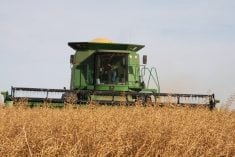In 1982, when Arnie Bergen-Henengouwen rented his first contract to grow sugar beets, it was a different crop. Seed genetics and technology had a long way to go, and there was a lot that could go wrong in a season.
“It was very intensive,” he says. “We were going over the crop at least once a week. We might spray seven times in a growing season. It wasn’t good for the environment, and it wasn’t good for producers.”
- Read more: Sugar beets just keep getting sweeter
- Read more: How high can we push sugar beet yields?
Read Also

Claas brings 1000 Series SP forage harvesters to Canada
In mid-August, Claas unveiled its new line of Jaguar forage harvesters at an event in Visalia, California, deep in the heart of that state’s dairy region.
Bergen-Henengouwen is the president of the Alberta Sugar Beet Growers, (ASBG). He says genetics have come a long way in the last few decades but it was the introduction of Roundup Ready sugar beets where growers have seen the biggest impact. The sector saw 95 per cent adoption of Roundup Ready sugar beets in 2009 and 100 per cent the following year.
He says since he’s been in the business it was the “typical weeds” — such as wild oats, kochia and wild buckwheat — growers were dealing with all the time. Some were exiting the sugar beet business altogether.
Recently Peter Regitnig, research agronomist with Lantic Inc., put today’s seeds to the test by growing them alongside an older variety.
“We still had some seed from the 1970s that we reproduced. We tested that seed relative to what we’re growing today for a couple years to see how much we have gained over a 40 year period,” he says.
Sugar beet gains are measured in two ways: yield and quality, which includes high sugar content and low impurities.
“Part of the gain we’ve seen in recent years has obviously been the adoption of Roundup Ready sugar beets. But a good part of it is also genetic improvement from seed companies,” Regitnig says.
Regitnig and his team applied the same conventional products to both the old variety and a current Roundup Ready to allow for a side-by-side comparison. They also grew another treatment of Roundup Ready beets with Roundup applied, which allowed them to measure the incremental differences of not applying conventional products.
“Some of the old herbicide products we used to use were hard on the crop, and they held the crop back compromising yield and quality,” Regitnig says. His study found approximately eight per cent more extractable sugar per acre with the same variety when it was sprayed with Roundup compared to conventional herbicides.
Better quality beets
Over the 40-year period, Regitnig has calculated an average gain of 52 per cent extractable sugar per acre. But quality in a sugar beet is determined not just by the amount of sugar, but the amount of impurities. Beets that have higher impurities such as amino nitrogen and sodium make it more difficult to extract sugar during processing. Those impurities were higher in the older variety.
On a subjective level, Regitnig’s research team noticed a visible difference in the root morphology between older and newer varieties.
“It’s not something we measured, but we noticed the shape of the root and the smoothness of it were much nicer-looking, and that’s not just an aesthetic advantage,” he says.
Root morphology can cause higher tare values, meaning more dirt may adhere to the root.
“Growers don’t want that and we don’t either because when we pile beets for long periods we want them to be as clean as possible,” Regitnig says.
Regitnig will be presenting the full findings of his research to his colleagues in the sugar beet sector in the U.S. in spring 2017.
Bergen-Henengouwen, who has been in the sugar beet business since the 1980s, says the old spraying regime and how it fit into the rotation cycle was the instigator that saw a lot of producers exiting. Before Roundup Ready varieties, growers had to be far more selective about where they planted sugar beets so they could avoid as many weeds as possible.
“It used to be that we would save our cleanest fields to grow beets on,” he says. “If the neighbour had a piece of land that was really weedy we would never try to rent it for beets. Now it doesn’t matter. Roundup can be used with far less weed management concerns.”
New varieties are trialed in Alberta each year, mainly varieties targeted specifically to Alberta’s conditions. Turnover is high — the oldest variety in use during the 2016 growing season was approved in 2012.














